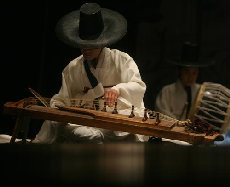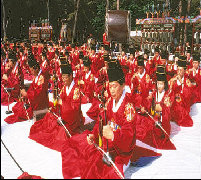Traditional Korean Music Is The Essence And Culture of South Korea
Traditional Korean Music can be classified on the basis of purpose and audience. A distinction can largely be made between folk and ritual where the classical tunes of the upper class is identified as separate from the Sogak of the common classes and usually engages the essence of life of the common villagers and worker.

Through songs that reflect hardships and toil and employing instrumental works that grow from their resources and experiences, everyday people create melodies that exhibit optimism and endeavor.
With lively rhythms and a willingness to experiment with clashes of forms, Korean melodies gains a spirit and sincerity that compares sharply with the more refined genre but the reciprocal roles of ritualistic and folk should be seen as a means of promoting each rather than a divisive factor.


Shaman ritual hym has a place in both and Hoisimgok, while born of a Buddhist chant, was adapted and popularized into the folk music spectrum. This ability to share melodies and themes could well be a product of the significance of religion in the lives of Korean families and communities. As well as the influence of Buddhism and Shamanism, the long standing and still present principles of Confucianism have supported and been enhanced through folk rythm.
By contrast, Chongak is a musical form that relates more closely to the upper class of Korean society. The depth of feeling, the soulful connection is less pronounced in Chongak where it reflects a more amusement or entertainment value.
 In discussing the traditional tunes of Korea, it is also important to acknowledge the instruments that produce the unique sound.
In discussing the traditional tunes of Korea, it is also important to acknowledge the instruments that produce the unique sound.
Like Western instruments, the classification can largely fall into string, wind and percussion, but the techniques required to play them are specialized.
For example, there are a number of twelve string instruments that are played through being plucked, struck or bowed, but this action is complemented by the dampening of the string to control the pitch and the length of the note.
While the wind instruments are played transverse or with the assistance of a reed, the harsh sound of brass has no place in the Korean repertoire. With regard to percussion instruments, there exists a wide range that includes xylophone-like panels to be struck melodically and drums and gongs to be played with a greater sense of rhythm.
The destiny of the Korean culture is an expression of the lives, experiences and status of the Korean people. Whether in ritual, amusement or response to the struggles of life, Korean rythm is an aspect of life held in high regard.
Music Back to South Korea Culture




